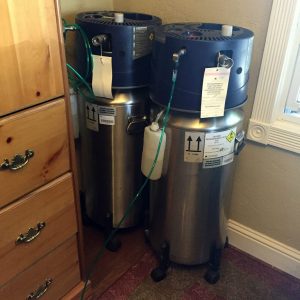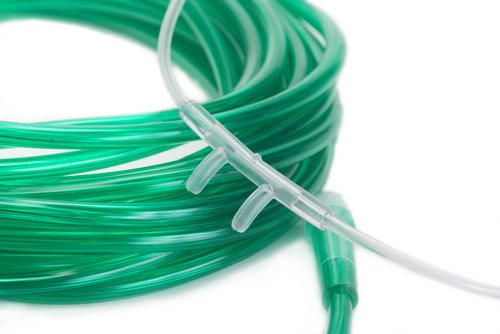Over the last two-plus years I have become an unwilling expert on the ins and outs of supplemental oxygen.
When I started using supplemental oxygen I knew next to nothing and found it very hard to get the help and information I needed. I’ve learned a lot and would like to pass on what I’ve learned to you. I am sharing based on my own experience and realize what I share may be incomplete. I’d love to get your input on this topic!
The use of supplemental oxygen must be ordered by a physician, approved by insurance and offered by the oxygen provider. Today I’ll be covering different types of oxygen I’ve used at home, and next week I’ll share options for using supplemental oxygen away from home.
Options for supplemental oxygen to use at home:
 Gas cylinders : Oxygen can be delivered to your home as compressed oxygen gas. This compressed gas is stored in steel and aluminum tanks or cylinders. Larger tanks are stationary and used at home. The top of the cylinder has a place for a “regulator.” This is a device that regulates, or controls, the air flow coming from an O2, or oxygen, cylinder, usually between 1 and 15 liters per minute. Your oxygen provider will deliver the amount of tanks or cylinders you need on a weekly or biweekly basis.
Gas cylinders : Oxygen can be delivered to your home as compressed oxygen gas. This compressed gas is stored in steel and aluminum tanks or cylinders. Larger tanks are stationary and used at home. The top of the cylinder has a place for a “regulator.” This is a device that regulates, or controls, the air flow coming from an O2, or oxygen, cylinder, usually between 1 and 15 liters per minute. Your oxygen provider will deliver the amount of tanks or cylinders you need on a weekly or biweekly basis.
 Oxygen concentrators: Oxygen concentrators are also available for home use. There are “low flow” concentrators, delivering 1 to 5 liters per minute of oxygen, and “high flow” concentrators that go up to 10 liters per minute. An oxygen concentrator is an electrical device about the size of an end table. It concentrates oxygen in the air by removing nitrogen, and then concentrates that oxygen, and sends it back to you to breathe through a nasal canula. This method is less expensive and easier to maintain, as it requires no refilling of tanks.
Oxygen concentrators: Oxygen concentrators are also available for home use. There are “low flow” concentrators, delivering 1 to 5 liters per minute of oxygen, and “high flow” concentrators that go up to 10 liters per minute. An oxygen concentrator is an electrical device about the size of an end table. It concentrates oxygen in the air by removing nitrogen, and then concentrates that oxygen, and sends it back to you to breathe through a nasal canula. This method is less expensive and easier to maintain, as it requires no refilling of tanks.
However, oxygen concentrators may give off heat and are noisy, and they may significantly increase your electricity bill. You will still need a back-up source of oxygen in case of a power failure, so make sure you have gas tanks on hand to use just in case. A humidifier bottle can be attached to the concentrator to add moisture to the dry air delivered by the concentrator.
When you need more than 10 liters per minute, you can hook two concentrators together with a Y connector to deliver more liters per minute. Check out my video below to see how this works.
Liquid oxygen: This is made by cooling oxygen gas and converting it to a liquid. Once approved, the provider delivers large tanks of liquid oxygen to the patient’s home, which must be filled weekly or biweekly by the oxygen provider. The biggest problem I have experienced using liquid oxygen is that some oxygen suppliers are reluctant to carry it or do not offer it at all because it is very expensive for them to provide. I had to fight for three months for my oxygen provider to be willing to deliver it to me, and another two months to bring me portable oxygen containers to use away from home.
Liquid oxygen tanks deliver only six liters per minute, but they can be hooked together with a Y connector to deliver 12 liters per minute with two tanks, or 18 liters per minute with three tanks. Check out my video to see how this works.
I prefer liquid oxygen over gas cylinders or a concentrator
 Liquid oxygen is slightly cool and soothing, and is much easier on my nose, which dries out terribly with a concentrator. This is especially important as the patient requires higher levels of oxygen.
Liquid oxygen is slightly cool and soothing, and is much easier on my nose, which dries out terribly with a concentrator. This is especially important as the patient requires higher levels of oxygen.
Portable oxygen containers (called strollers) hold more and weigh less than gas cylinders, and are easier for me to use when out and about. I’ll talk more about these next week.
Insurance coverage
Supplemental oxygen is very expensive. Most insurance plans cover this cost, but some do not. I’ve had both experiences. My first provider did not cover supplemental oxygen in their individual plans (which I had). They did cover it in their group plans. I took my insurance company to the state insurance board, but lost. I had to buy my own equipment. My current insurance company covers the cost, and I’ve had no problems with them. Please check directly with your insurance company about what your policy covers.
I’ve created the video above to show you my equipment so you can see up close what the options are. I hope it is helpful to you. Check back next week when I share different types of portable oxygen possibilities.
I’d love to hear from you! What was helpful for you about this post or video? What other experiences about using supplemental oxygen at home could you share with us?
Please share this post with anyone you feel could benefit, or on social media. We’re in this together!
***
Note: Lung Disease News is strictly a news and information website about the disease. It does not provide medical advice, diagnosis, or treatment. This content is not intended to be a substitute for professional medical advice, diagnosis, or treatment. Always seek the advice of your physician or other qualified health provider with any questions you may have regarding a medical condition. Never disregard professional medical advice or delay in seeking it because of something you have read on this website. The opinions expressed in this column are not those of Lung Disease News or its parent company, BioNews Services, and are intended to spark discussion about issues pertaining to pulmonary fibrosis.


very good video Kim as I am in Ontario Canada we are very lucky everything I need has been supplied free of charge to me & MEDIGAS have been wonderful to me in the last almost 3 years–Ray Emerson from Stirling Ontario canada
Kim,
Your utility may have a rate reduction program for people operating high-power-drain equipment such as a concentrator. Here in CO they don’t make a big noise about the plan, which is administered through a third party which requires some personal (income, etc.) info. before you’re approved. Each state is different, and some may not have any such rate reduction plan.
But it doesn’t hurt to ask.